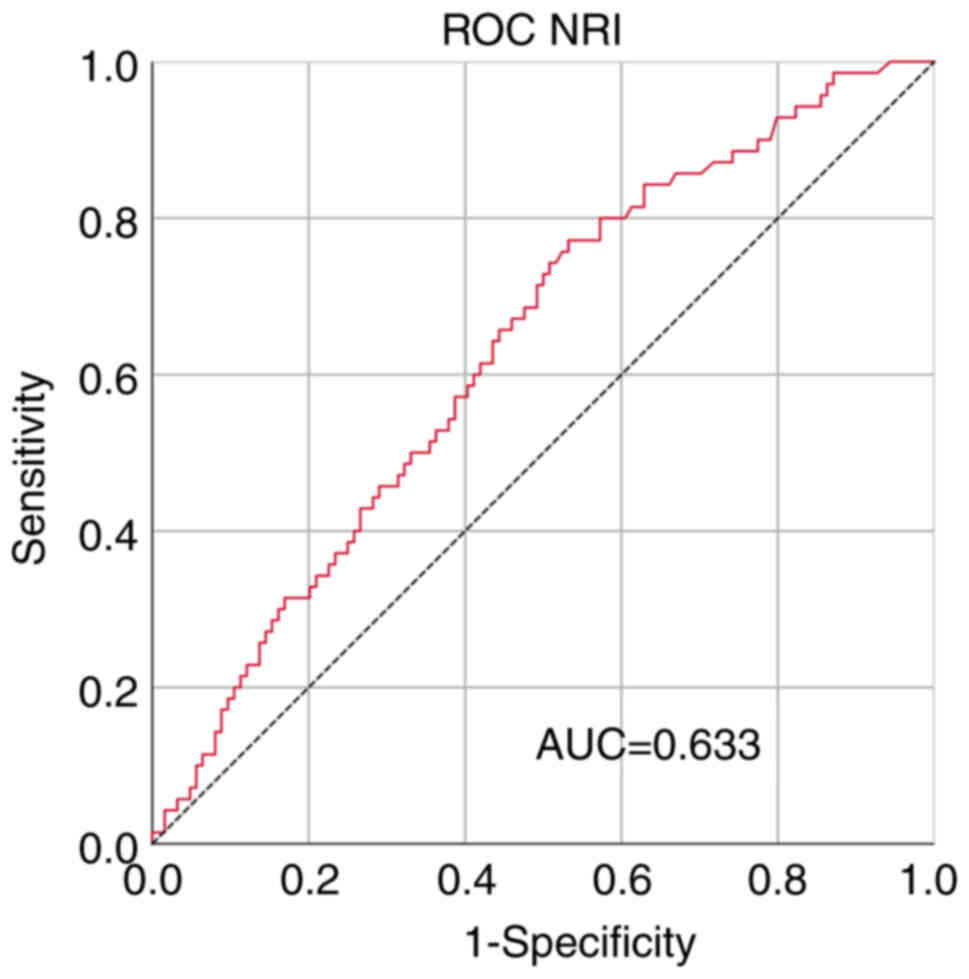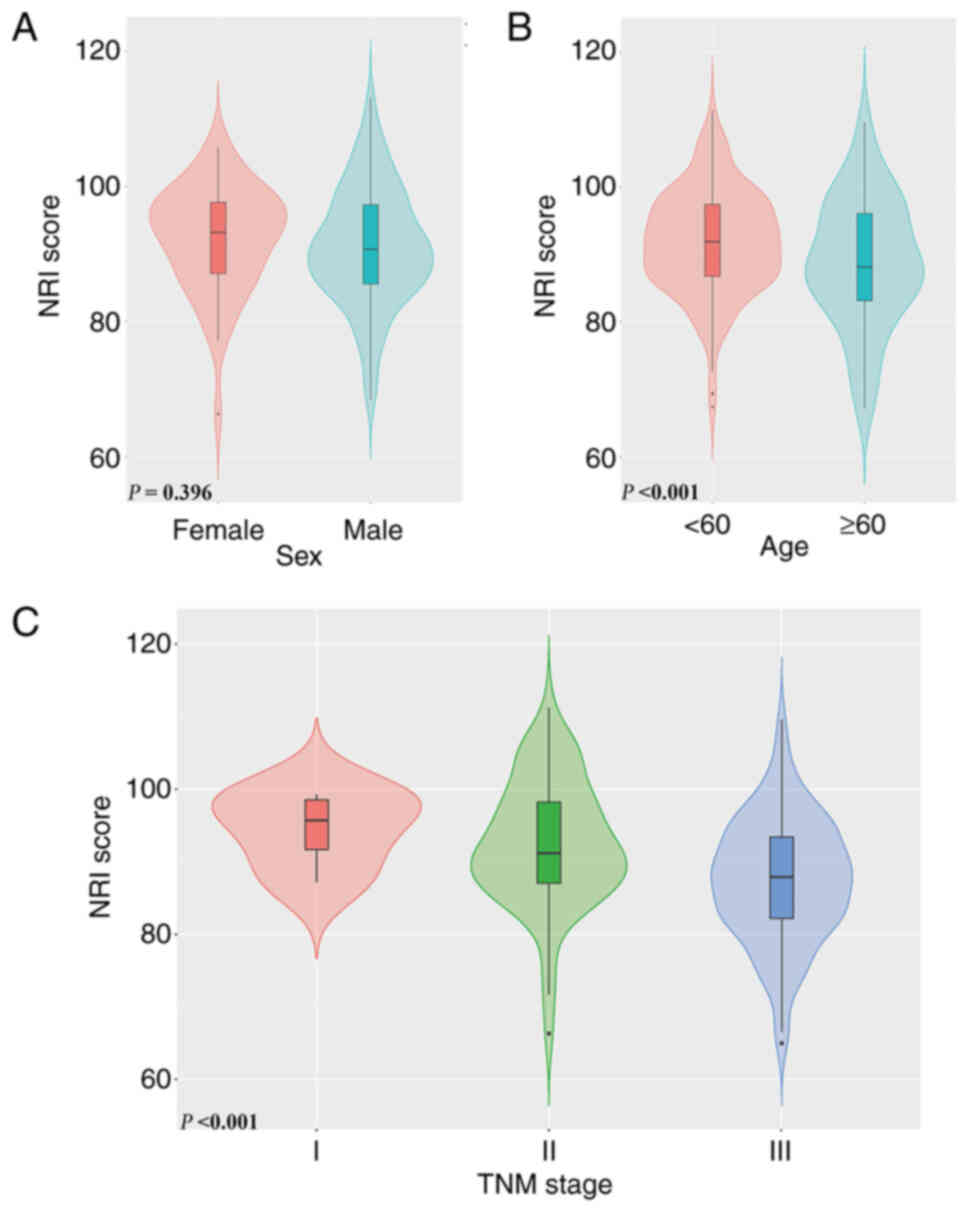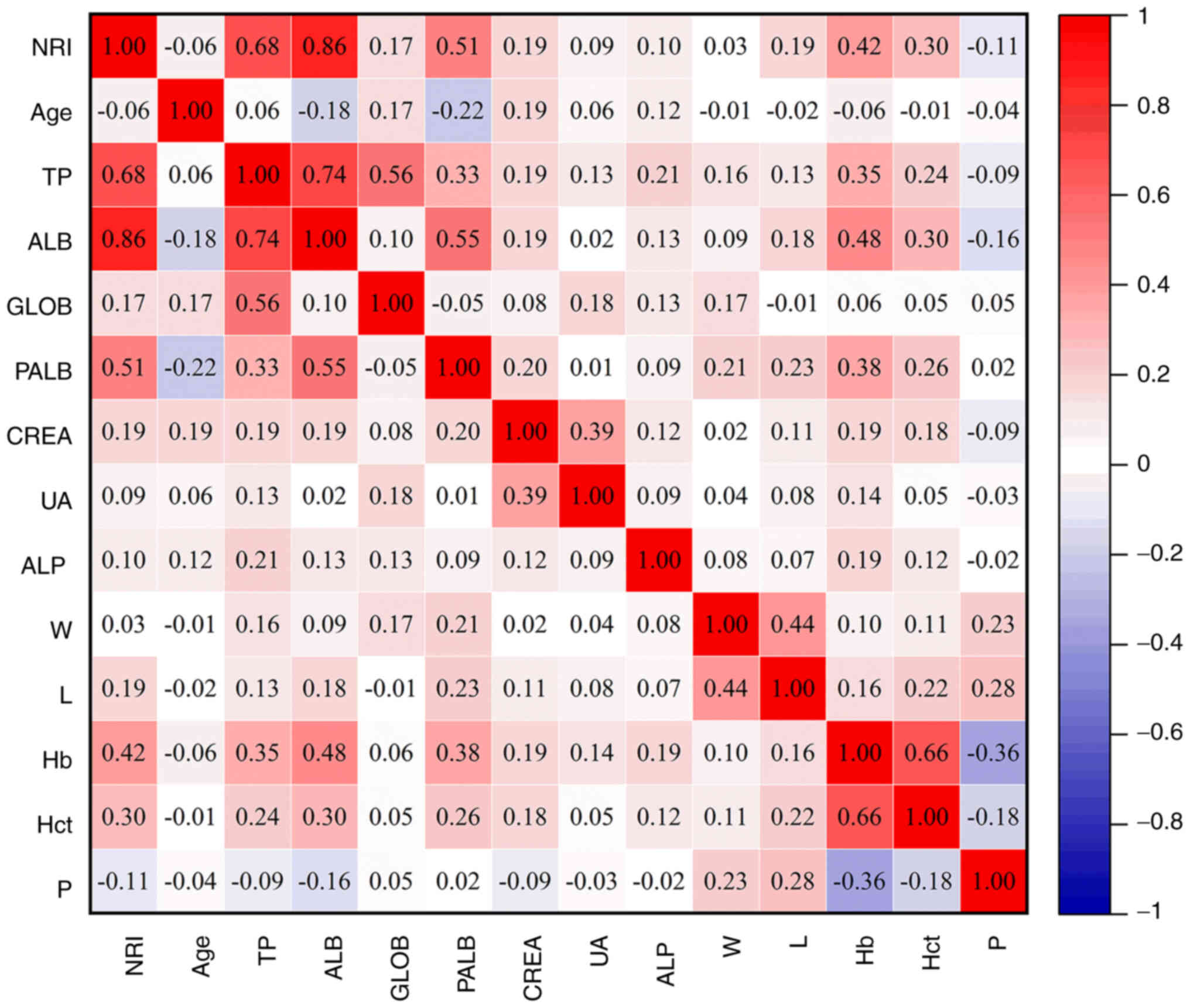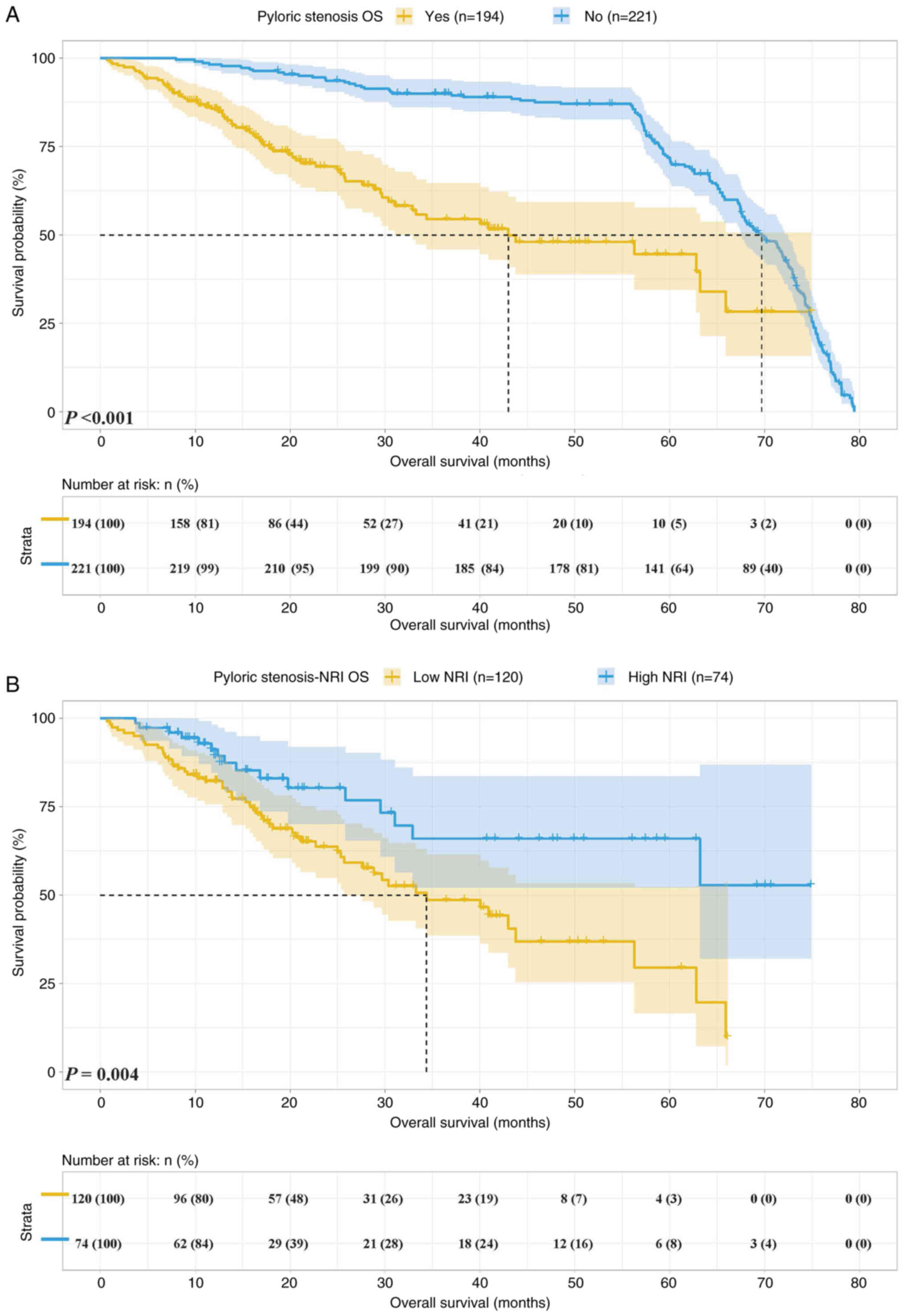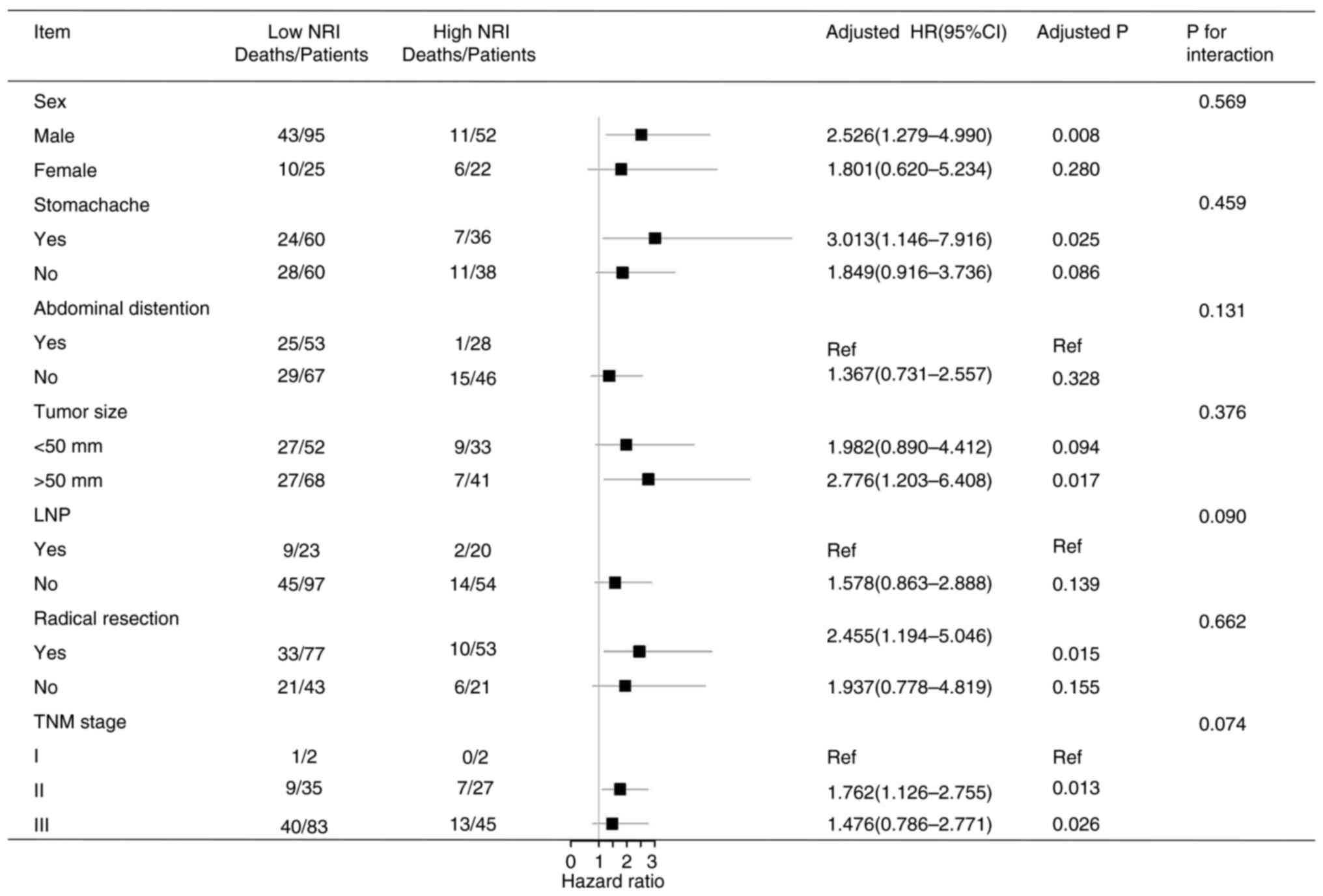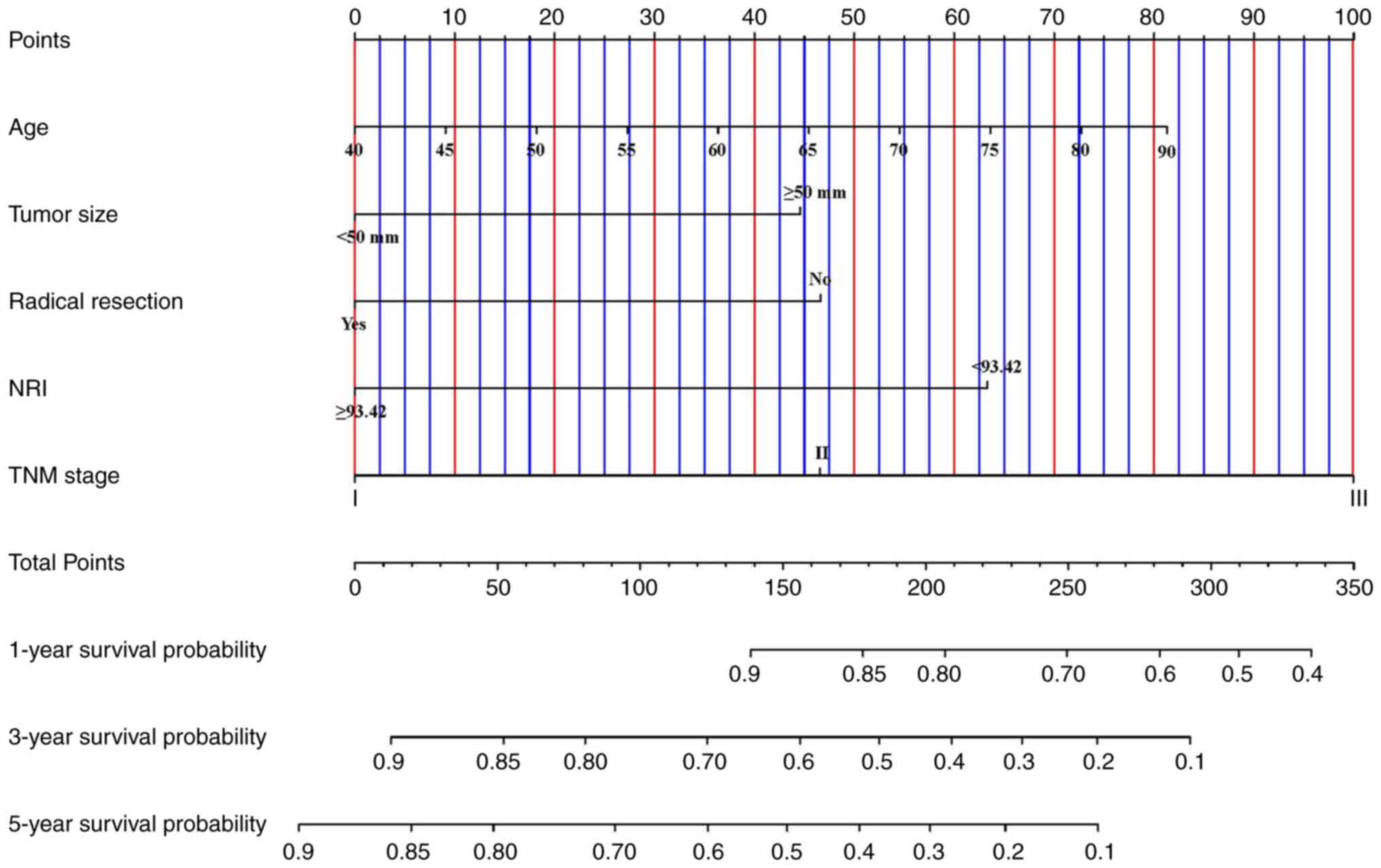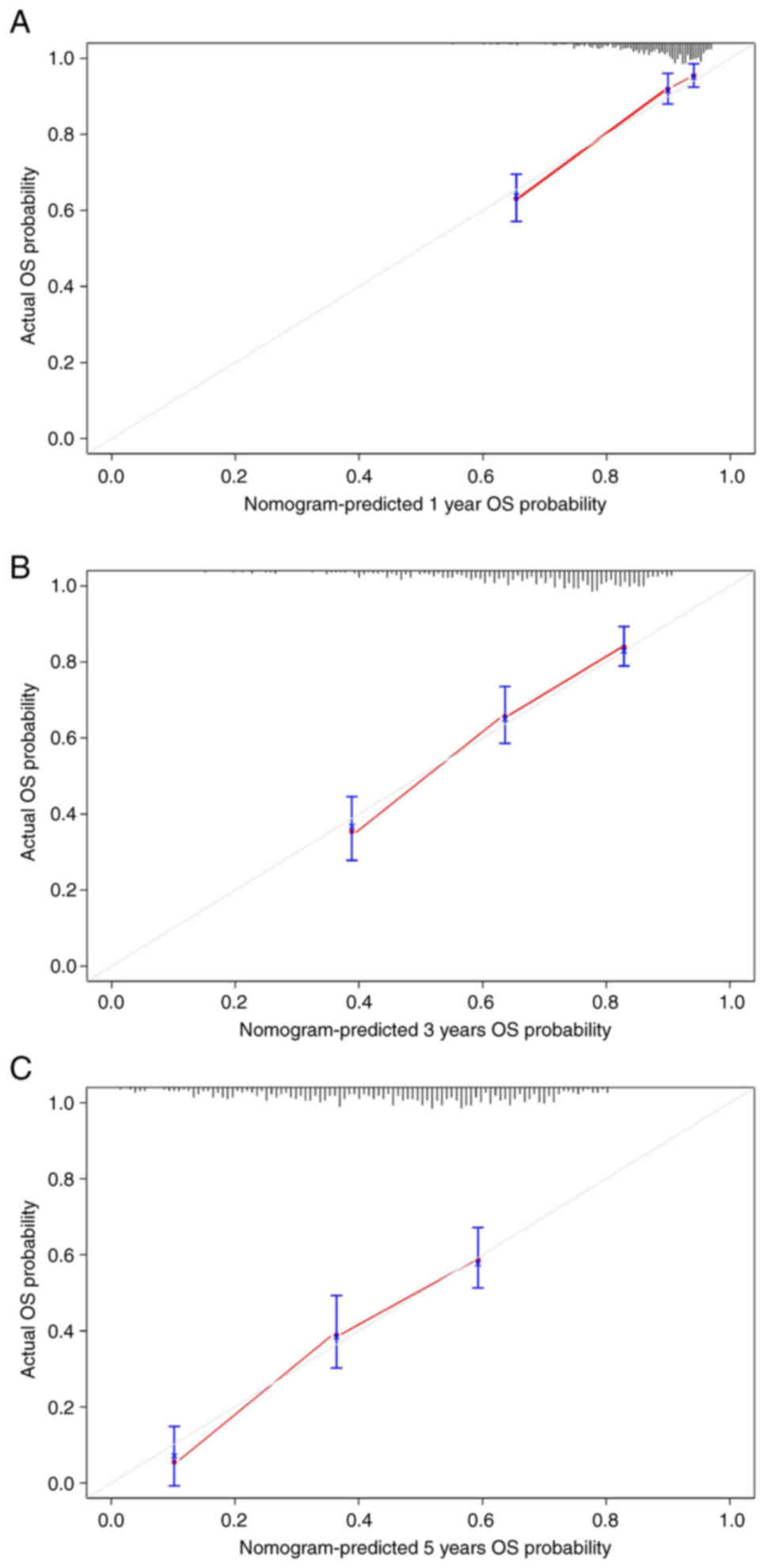Nutritional risk index predicts the prognosis of gastric cancer patients with pyloric stenosis who received preoperative parenteral nutrition
- Authors:
- Published online on: July 31, 2023 https://doi.org/10.3892/ol.2023.13988
- Article Number: 401
-
Copyright: © Li et al. This is an open access article distributed under the terms of Creative Commons Attribution License.
Abstract
Introduction
As the fifth most common cancer type and the third leading cause of cancer-related death worldwide, gastric cancer remains a serious health challenge (1). Cancer patients with poor nutritional status are not only limited in their choice of treatment strategies but also often have worse clinical outcomes (2,3). The nutritional status of cancer patients deserves attention, particularly that of patients with digestive tract cancers (4,5).
Pyloric stenosis is a common complication in patients with gastric cancer, particularly in antral tumors (6). Mechanical obstruction of the pyloric duct due to tumor progression causes patients to suffer from digestive system symptoms such as abdominal pain, bloating and loss of appetite, which severely affects energy intake. The increase in energy consumption caused by cancer makes the nutritional status of patients with pyloric stenosis deteriorate rapidly, even leading to cachexia (7–9). Numerous studies have explored that poor nutritional status was an important negative influence on the development of postoperative complications and on prognosis (10–12). Parenteral nutrition is an important treatment strategy for malnourished cancer patients. Preoperative parenteral nutrition may not only improve the treatment tolerance of cancer patients but also reduce the occurrence of postoperative complications and perioperative mortality (13).
The nutritional risk index (NRI) incorporates changes in patient weight and serum albumin levels, making it an accurate scoring system for evaluating the nutritional status of cancer patients (14). Numerous studies have revealed a significant association between NRI and clinical outcomes in a variety of cancer types, including gastric cancer (15–17). Patients with gastric cancer with pyloric stricture who received preoperative parenteral nutrition have a unique nutritional status and the predictive ability of the NRI for them has remained to be clarified. The present study analyzed the pathological characteristics and clinical outcomes of patients with gastric cancer with pyloric stricture in detail and explored the predictive ability of NRI for the prognosis of patients with gastric cancer with pyloric stricture who received preoperative parenteral nutrition. These results provided a reference for evaluating the severity of the disease and the risk of postoperative recurrence.
Materials and methods
Patients
The present study included 415 patients with gastric cancer treated at The Second People's Hospital of Neijiang (Neijiang, China) between January 2016 and December 2021, including 194 cases with pyloric stenosis who received preoperative parenteral nutrition and 221 cases without pyloric stenosis. The inclusion criteria were as follows: i) All subjects were confirmed by pathological diagnosis; ii) all subjects received surgical treatment; iii) pyloric stenosis was confirmed by electric gastroscope or imaging examination; iv) all subjects with pyloric stenosis received parenteral nutrition for 3–14 days before the surgery; and v) all subjects had complete clinical information. Patients with pyloric stenosis received a peripherally inserted central catheter or central venous catheter within 24 h after admission. Parenteral nutrient solutions were Kabiven Peripheral (1,920 ml) or Kabiven Peripheral (1,440 ml) (Fresenius Kabi AG). This study was based on the Helsinki Declaration as well as its amendments and the protocol was approved by the Ethics Committee of the Second People's Hospital of Neijiang (Neijiang, China). This study was retrospective and did not require informed consent.
Data collection
The observation outcome of the present study was overall survival (OS), which was defined as the period from the first day of treatment to death or the last follow-up and was obtained by telephone follow-up. The NRI was calculated as follows: NRI=1.519 × albumin (g/l) + 41.7 × personal weight (kg)/ideal weight (kg) (14). The ideal weight was calculated by the Lorentz equations, which were as follows: Male ideal weight (kg)=height (m)-100-[(height (m)-150)/4]; female ideal weight (kg)=height (m)-100-[(height (m)-150)/2.5]. The cut-off point for the NRI in patients with pyloric stenosis was obtained from the receiver operating characteristic (ROC) curve. The area under curve of the ROC curve at the maximum Youden index of 0.239 was 0.633, with sensitivity and specificity values of 0.771 and 0.468, respectively (Fig. 1). All patients were divided into the low-value group (NRI<93.42) and the high-value group (NRI ≥93.42).
Statistical analysis
All analyses were completed by R 4.2.2 and continuous variables were expressed as the mean ± standard deviation and compared by Student's t-test and Pearson's correlation analysis, while categorical variables were reported as the number of patients and percentage and compared by the Chi-square test or Fisher's exact test. Kaplan-Meier survival curves and the log-rank test were used to compare differences in survival time. Univariate and multivariate Cox's analyses were conducted to identify significant prognostic markers and the predictive ability of NRI for OS was further explored through stratified analyses. Nomograms were also constructed the calibration curves were drawn to analyze the predictive effectiveness of the nomograms. A two-sided P<0.05 was considered to indicate a statistically significant difference.
Results
Patient characteristics
Of the 415 subjects included, 295 (71.1%) were males and 120 (28.9%) were females, with a mean (± SD) age of 60.83±10.42 years. There were 194 patients (46.7%) with pyloric stenosis, and it was observed that subjects with pyloric stenosis had a higher age, larger proportion of males, lower body mass index (BMI), longer length of stay, lower occurrence of stomachache, a higher occurrence of abdominal distension, weight loss and sour regurgitation, a larger proportion of cases with lymph node-positive status, TNM stage III and lower NRI, as well as larger tumor size and poorer blood parameters (all P<0.05). In addition, Fisher's exact test indicated that tumors in patients with pyloric stenosis tended to be less frequently subjected to radical resection (P<0.001), and more frequently located in the lower 1/3 (P=0.025), moderately differentiated (P=0.004) and of the Borrmann type III (P<0.001) (Table I).
NRI
Comparisons of different groups of patients with pyloric stenosis revealed that there was no significant difference in the NRI score among patients with different sex (P=0.396). However, patients with higher age had a lower NRI score (P<0.001). Furthermore, a decrease in the NRI score was observed to be associated with an increase in TNM stage (P<0.001) (Fig. 2A-C). After conducting a Gaussian distribution test on the data, Pearson correlation analysis was performed on all parameters that satisfied the criteria for a Gaussian distribution. The NRI was found to be significantly correlated with higher total protein, albumin (ALB), pre-ALB, hemoglobin and hematocrit (all R>0.3, P<0.05) (Fig. 3).
All cases were stratified into two groups based on the cut-off point of the NRI. There were 120 patients (61.9%) with NRI <93.42 and 74 patients (38.1%) with NRI ≥93.42. The NRI was related to age, BMI, TNM stage and extensive blood parameters (all P<0.05) (Table II).
Survival analysis for NRI
The cohort of the present study included 194 cases (46.7%) with pyloric stenosis and 221 cases (53.3%) with non-pyloric stenosis. The 1-year survival rate of patients with pyloric stenosis and non-pyloric stenosis was 85.7 and 98.2%, while the 3-year survival rate was 54.5 vs. 90.0% and the 5-year survival rate was 44.6 and 71.9%, respectively. Patients with pyloric stenosis had a shorter OS [median survival time (MST): 42.71 vs. 69.92 months, P<0.001] (Fig. 4A).
Among the patients with pyloric stenosis, there were 120 cases (61.9%) with NRI <93.42 and 74 cases (38.1%) with NRI ≥93.42. The 1- and 3-year survival rates of patients with NRI <93.42 and NRI ≥93.42 were 82.2 and 48.7 vs. 91.2 and 66.0%, respectively. Patients with NRI <93.42 had shorter OS (MST: 34.37 months vs. not reached, P=0.004) (Fig. 4B).
Univariate and multivariate survival analysis
In the present study, OS was related to age, ALB, NRI, radical resection, tumor size and TNM stage (all P<0.05). The independent prognostic factors for OS were age, NRI, radical resection, tumor size and TNM stage (all P<0.05) (Table III). In addition, a stratified analysis was performed according to the multivariate analysis. It was found that a low NRI was associated with a shorter survival time in patients who were males and those who had a stomachache, tumor size ≥50 mm, radical resection, TNM stage II and TNM stage III (all P<0.05) (Fig. 5).
Nomogram for OS
Finally, a nomogram was established to predict the survival probability of patients with pyloric stenosis based on independent prognostic factors obtained from the multivariate analysis (Fig. 6). To verify the predictive ability of the nomogram, a bootstrap calibration was conducted and the calibration curves were plotted (Fig. 7A-C). The C-index of the nomogram was 0.760 (95%CI: 0.688–0.832) and the calibration curves also showed good predictive ability.
Discussion
Pyloric stenosis is a common complication in patients with gastric cancer, which is related to the site of tumor growth and disease progression. However, detailed and comprehensive studies on the clinical and pathological characteristics and prognosis of patients with gastric cancer with pyloric stenosis are still lacking. In addition, patients with pyloric stenosis may present with malnutrition early. Therefore, preoperative parenteral nutrition is essential to restore patients' surgical tolerance. The predictive ability of the NRI regarding the prognosis of such patients had so far remained elusive.
Certain clinical studies have reported on patients with gastric cancer with early pyloric stenosis. In 1998, Watanabe et al (6) analyzed 122 gastric cancer patients with pyloric stenosis and found that those cases had faster disease progression and a higher probability of distant metastasis. In addition, they also found that operation was a significant prognostic factor for patients with pyloric stenosis, even if the tumor had distant metastasis. Another study by Mizutani et al (18) also found that patients with pyloric stenosis were more inclined to be stage IV and surgery was able to improve their prognosis. Of note, the NRI has been widely used in cancer for numerous years. Xie et al (16) combined the NRI and handgrip strength to predict the survival rate of patients with cancer cachexia and they found that NRI was an independent prognostic factor for cancer cachexia. Oh et al (19) analyzed the application of NRI in patients with head and neck cancer who received concurrent chemo-radiotherapy. They collected 110 patients and found that the NRI was able to predict OS and complications of their subjects. The close relationship between gastric cancer and nutritional status made the NRI equally widely used in gastric cancer. Song et al (20) specifically studied the predictive ability of the NRI regarding the prognosis of patients with stage III gastric cancer. Their results indicated that the NRI was related to a shorter survival time. Other studies on gastric cancer had also reached similar conclusions (21–25).
The present study mainly reported on the clinical and pathological characteristics of patients with gastric cancer with pyloric stricture and analyzed the application of the NRI in patients with gastric cancer with pyloric stricture who received preoperative parenteral nutrition. Correlation analysis indicated that pyloric stenosis was significantly associated with faster disease progression and poorer blood parameters. The NRI also had a strong predictive ability for OS in patients with pyloric stricture. In addition, further multivariate analysis of all patients with gastric cancer found that the NRI was an independent prognostic marker of OS. Finally, the bootstrap correction for the nomogram also showed good consistency between the predicted probability and the actual probability.
The causes of malnutrition in patients with gastric cancer with pyloric stenosis were multiple, mainly related to feeding difficulties and disease progression (26–30). The present study indicated that patients with pyloric stenosis were more prone to abdominal distension and higher TNM stage, which were the main reasons for malnutrition and shorter survival (31–34). The NRI contains ALB levels and body weight, which are closely related to the prognosis of patients with gastric cancer (35–37). ALB not only reflects the nutritional status of patients but also correlates with the systemic inflammatory status (38). Inflammatory factors may act on the liver and inhibit the synthesis of ALB by the liver (39,40). Low serum levels of ALB reflect poor hepatic functional reserve of patients to a certain extent, leading to worse treatment tolerance and shorter survival time (41). The body weight also reflects the nutritional status and it is associated with surgery or chemotherapy tolerance in cancer patients (42). Several studies have indicated that body weight was a strong independent prognostic factor for patients with gastric cancer and the predictive ability of the BMI regarding the clinical outcomes of patients with gastric cancer who received immune checkpoint inhibitors has also been confirmed (43,44).
Due to the retrospective nature of the present study, a certain degree of information bias was inevitable. In addition, the parenteral nutrition for certain patients with mild malnutrition was affected by the operation schedule and did not reach the optimal nutritional status. The present study was only for patients with pyloric stenosis and did not consider gastric emptying disorders due to other causes, such as Borrmann IV gastric cancer. Finally, although the NRI could accurately reflect the nutritional status of patients, it may be more effective when combined with other factors that reflect the inflammatory status or tumor progression. The conclusions of the present study still require to be further verified by numerous prospective studies.
In conclusion, the NRI was an accurate score reflecting the nutritional status of patients, which could predict the clinical outcomes for patients with gastric cancer with pyloric stricture who received preoperative parenteral nutrition. Patients with a low NRI had shorter survival times.
Acknowledgements
Not applicable.
Funding
Funding: No funding was received.
Data availability statement
All data generated or analyzed during this study are included in this published article.
Authors' contributions
GL designed and conducted the study, and drafted the manuscript. HS and LH were responsible for data collection, analysis and interpretation. GL and HS confirm the authenticity of all the raw data. All authors have read and approved the final version of the manuscript.
Ethics approval and consent to participate
This study was approved by the ethics committee of the Second People's Hospital of Neijiang (Neijiang, China) (approval no. LSY2022015). All patients provided written informed consent before the study.
Patient consent for publication
Not applicable.
Competing interests
The authors declare that they have no competing interests.
References
|
Thrift AP and El-Serag HB: Burden of gastric cancer. Clin Gastroenterol Hepatol. 18:534–542. 2020. View Article : Google Scholar : PubMed/NCBI | |
|
Bullock AF, Greenley SL, McKenzie GAG, Paton LW and Johnson MJ: Relationship between markers of malnutrition and clinical outcomes in older adults with cancer: Systematic review, narrative synthesis and meta-analysis. Eur J Clin Nutr. 74:1519–1535. 2020. View Article : Google Scholar : PubMed/NCBI | |
|
Viana ECRM, Oliveira IDS, Rechinelli AB, Marques IL, Souza VF, Spexoto MCB, Pereira TSS and Guandalini VR: Malnutrition and nutrition impact symptoms (NIS) in surgical patients with cancer. PLoS One. 15:e02413052020. View Article : Google Scholar : PubMed/NCBI | |
|
Poisson J, Martinez-Tapia C, Heitz D, Geiss R, Albrand G, Falandry C, Gisselbrecht M, Couderc AL, Boulahssass R, Liuu E, et al: Prevalence and prognostic impact of cachexia among older patients with cancer: A nationwide cross-sectional survey (NutriAgeCancer). J Cachexia Sarcopeni Muscle. 12:1477–1488. 2021. View Article : Google Scholar : PubMed/NCBI | |
|
Pobłocki J, Jasińska A, Syrenicz A, Andrysiak-Mamos E and Szczuko M: The neuroendocrine neoplasms of the digestive tract: Diagnosis, treatment and nutrition. Nutrients. 12:14372020. View Article : Google Scholar : PubMed/NCBI | |
|
Watanabe A, Maehara Y, Okuyama T, Kakeji Y, Korenaga D and Sugimachi K: Gastric carcinoma with pyloric stenosis. Surgery. 123:330–334. 1998. View Article : Google Scholar : PubMed/NCBI | |
|
Xu R, Chen XD and Ding Z: Perioperative nutrition management for gastric cancer. Nutrition. 93:1114922022. View Article : Google Scholar : PubMed/NCBI | |
|
Izumi D, Ida S, Hayami M, Makuuchi R, Kumagai K, Ohashi M, Watanabe M, Sano T and Nunobe S: Increased rate of serum prealbumin level after preoperative enteral nutrition as an indicator of morbidity in gastrectomy for gastric cancer with outlet obstruction. World J Surg. 46:624–630. 2022. View Article : Google Scholar : PubMed/NCBI | |
|
Gong C, Wan Q, Zhao R, Zuo X, Chen Y and Li T: Cachexia index as a prognostic indicator in patients with gastric cancer: A retrospective study. Cancers (Basel). 14:44002022. View Article : Google Scholar : PubMed/NCBI | |
|
Aprile G, Basile D, Giaretta R, Schiavo G, La Verde N, Corradi E, Monge T, Agustoni F and Stragliotto S: The clinical value of nutritional care before and during active cancer treatment. Nutrients. 13:11962021. View Article : Google Scholar : PubMed/NCBI | |
|
Saroul N, Puechmaille M, Lambert C, Hassan AS, Biau J, Lapeyre M, Mom T, Bernadach M and Gilain L: Prognosis in head and neck cancer: Importance of nutritional and biological inflammatory status. Otolaryng Head Neck. 166:118–127. 2022. View Article : Google Scholar | |
|
Steenhagen E, van Vulpen JK, van Hillegersberg R, May AM and Siersema PD: Nutrition in peri-operative esophageal cancer management. Expert Rev Gastroenterol Hepatol. 11:663–672. 2017. View Article : Google Scholar : PubMed/NCBI | |
|
Lakananurak N and Gramlich L: The role of preoperative parenteral nutrition. Nutrients. 12:13202020. View Article : Google Scholar : PubMed/NCBI | |
|
Lin F, Xia W, Chen M, Jiang T, Guo J, Ouyang Y, Sun H, Chen X, Deng W, Guo L and Lin H: A prognostic model based on nutritional risk index in operative breast cancer. Nutrients. 14:37832022. View Article : Google Scholar : PubMed/NCBI | |
|
Kim KW, Lee K, Lee JB, Park T, Khang S, Jeong H, Ko CS, Yook JH, Kim BS and Lee IS: Preoperative nutritional risk index and postoperative one-year skeletal muscle loss can predict the prognosis of patients with gastric adenocarcinoma: A registry-based study. BMC Cancer. 21:1572021. View Article : Google Scholar : PubMed/NCBI | |
|
Xie H, Ruan G, Zhang Q, Ge Y, Song M, Zhang X, Liu X, Lin S, Zhang X, Li X, et al: Combination of nutritional risk index and handgrip strength on the survival of patients with cancer cachexia: A multi-center cohort study. J Inflamm Res. 15:1005–1015. 2022. View Article : Google Scholar : PubMed/NCBI | |
|
Chen L, Qi Y, Kong X, Su Z, Wang Z, Wang X, Du Y, Fang Y, Li X and Wang J: Nutritional risk index predicts survival in patients with breast cancer treated with neoadjuvant chemotherapy. Front Nutr. 8:7867422021. View Article : Google Scholar : PubMed/NCBI | |
|
Mizutani S, Shioya T, Maejima K, Yoshino M, Komine O, Bou H, Ogata M, Watanabe M, Shibuya T, Tokunaga A and Tajiri T: Significance of gastrectomy as palliative surgery for gastric carcinoma with pyloric stenosis. J Nippon Med Sch. 74:241–245. 2007. View Article : Google Scholar : PubMed/NCBI | |
|
Oh J, Liu A, Tran E, Berthelet E, Wu J, Olson RA, Chau N, Bowman A and Hamilton SN: Association between nutritional risk index and outcomes for head and neck cancer patients receiving concurrent chemo-radiotherapy. Head Neck. 42:2560–2570. 2020. View Article : Google Scholar : PubMed/NCBI | |
|
Song H, Sun H, Yang L, Gao H, Cui Y, Yu C, Xu H and Li L: Nutritional risk index as a prognostic factor predicts the clinical outcomes in patients with stage III gastric cancer. Front Oncol. 12:8804192022. View Article : Google Scholar : PubMed/NCBI | |
|
Ma LX, Taylor K, Espin-Garcia O, Anconina R, Suzuki C, Allen MJ, Honorio M, Bach Y, Allison F, Chen EX, et al: Prognostic significance of nutritional markers in metastatic gastric and esophageal adenocarcinoma. Cancer Med. 10:199–207. 2021. View Article : Google Scholar : PubMed/NCBI | |
|
Fujiya K, Kawamura T, Omae K, Makuuchi R, Irino T, Tokunaga M, Tanizawa Y, Bando E and Terashima M: Impact of malnutrition after gastrectomy for gastric cancer on long-term survival. Ann Surg Oncol. 25:974–983. 2018. View Article : Google Scholar : PubMed/NCBI | |
|
Vicente MA, Barão K, Silva TD and Forones NM: What are the most effective methods for assessment of nutritional status in outpatients with gastric and colorectal cancer? Nutr Hosp. 28:585–591. 2013.PubMed/NCBI | |
|
Karabulut S, Dogan I, Afsar CU, Karabulut M, Ak N, Duran A and Tastekin D: Does nutritional status affect treatment tolerability, chemotherapy response and survival in metastatic gastric cancer patients? Results of a prospective multicenter study in Turkey. J Oncol Pharm Pract. 28:127–134. 2022. View Article : Google Scholar : PubMed/NCBI | |
|
Seo SH, Kim SE, Kang YK, Ryoo BY, Ryu MH, Jeong JH, Kang SS, Yang M, Lee JE and Sung MK: Association of nutritional status-related indices and chemotherapy-induced adverse events in gastric cancer patients. BMC Cancer. 16:9002016. View Article : Google Scholar : PubMed/NCBI | |
|
Przekop Z, Szostak-Węgierek D, Milewska M, Panczyk M, Zaczek Z and Sobocki J: Efficacy of the nutritional risk index, geriatric nutritional risk index, BMI, and GLIM-defined malnutrition in predicting survival of patients with head and neck cancer patients qualified for home enteral nutrition. Nutrients. 14:12682022. View Article : Google Scholar : PubMed/NCBI | |
|
Ongaro E, Buoro V, Cinausero M, Caccialanza R, Turri A, Fanotto V, Basile D, Vitale MG, Ermacora P, Cardellino GG, et al: Sarcopenia in gastric cancer: When the loss costs too much. Gastric Cancer. 20:563–572. 2017. View Article : Google Scholar : PubMed/NCBI | |
|
Martin L, Jia C, Rouvelas I and Lagergren P: Risk factors for malnutrition after oesophageal and cardia cancer surgery. Br J Surg. 95:1362–1328. 2008. View Article : Google Scholar : PubMed/NCBI | |
|
Huang DD, Yu DY, Wang WB, Song HN, Luo X, Wu GF, Chen XL, Yu Z and Yan JY: Global leadership initiative in malnutrition (GLIM) criteria using hand-grip strength adequately predicts postoperative complications and long-term survival in patients underwent radical gastrectomy for gastric cancer. Eur J Clin Nutr. 76:1323–1331. 2022. View Article : Google Scholar : PubMed/NCBI | |
|
Li Q, Zhang X, Tang M, Song M, Zhang Q, Zhang K, Ruan G, Zhang X, Ge Y, Yang M, et al: Different muscle mass indices of the Global leadership initiative on malnutrition in diagnosing malnutrition and predicting survival of patients with gastric cancer. Nutrition. 89:1112862021. View Article : Google Scholar : PubMed/NCBI | |
|
Xu R, Gu Q, Xiao S, Zhao P and Ding Z: Patient-reported gastrointestinal symptoms following surgery for gastric cancer and the relative risk factors. Front Oncol. 12:9514852022. View Article : Google Scholar : PubMed/NCBI | |
|
Zhang J, Zou S, Luo R, Zhu Z, Xu H and Huang B: Proposal of a novel stage grouping of the eighth edition of American joint committee on cancer TNM staging system for gastric cancer: Results from a retrospective study of 30 years clinical data from a single institute in China. Expert Rev Gastroenterol Hepatol. 14:55–64. 2020. View Article : Google Scholar : PubMed/NCBI | |
|
Zhuang CL, Dong QT, Chen XL and Wang SL: ASO author reflections: Comparison of sarcopenia and cachexia for their prognostic value in gastric cancer patients at different TNM stages after gastrectomy. Ann Surg Oncol. 29:585–586. 2022. View Article : Google Scholar : PubMed/NCBI | |
|
Cai W, Yang H, Zheng J, Huang J, Ji W, Lu Y, Yang X, Zhang W, Shen X and Chen X: Global leaders malnutrition initiative-defined malnutrition affects long-term survival of different subgroups of patients with gastric cancer: A propensity score-matched analysis. Front Nutr. 9:9952952022. View Article : Google Scholar : PubMed/NCBI | |
|
Zhang Y, Zhu JY, Zhou LN, Tang M, Chen MB and Tao M: Predicting the prognosis of gastric cancer by albumin/globulin ratio and the prognostic nutritional index. Nutr Cancer. 72:635–644. 2020. View Article : Google Scholar : PubMed/NCBI | |
|
Lin GT, Ma YB, Chen QY, Zhong Q, Zheng CH, Li P, Xie JW, Wang JB, Lin JX and Huang CM: Fibrinogen-albumin ratio as a new promising preoperative biochemical marker for predicting oncological outcomes in gastric cancer: A multi-institutional study. Ann Surg Oncol. 28:7063–7073. 2021. View Article : Google Scholar : PubMed/NCBI | |
|
Wang N, Jiang J, Xi W, Wu J, Zhou C, Shi M, Wang C, Zhu Z, Liu J and Zhang J: Postoperative BMI loss at one year correlated with poor outcomes in Chinese gastric cancer patients. Int J Med Sci. 17:2276–2284. 2020. View Article : Google Scholar : PubMed/NCBI | |
|
Evans DC, Corkins MR, Malone A, Miller S, Mogensen KM, Guenter P and Jensen GL: The use of visceral proteins as nutrition markers: An ASPEN position paper. Nutr Clin Pract. 36:22–28. 2021. View Article : Google Scholar : PubMed/NCBI | |
|
Coffelt SB and de Visser KE: Cancer: Inflammation lights the way to metastasis. Nature. 507:48–49. 2014. View Article : Google Scholar : PubMed/NCBI | |
|
Bito R, Hino S, Baba A, Tanaka M, Watabe H and Kawabata H: Degradation of oxidative stress-induced denatured albumin in rat liver endothelial cells. Am J Physiol Cell Physiol. 289:C531–C542. 2005. View Article : Google Scholar : PubMed/NCBI | |
|
Terashima T, Yamashita T, Arai K, Kawaguchi K, Kitamura K, Yamashita T, Sakai Y, Mizukoshi E, Honda M and Kaneko S: Beneficial effect of maintaining hepatic reserve during chemotherapy on the outcomes of patients with hepatocellular carcinoma. Liver Cancer. 6:236–249. 2017. View Article : Google Scholar : PubMed/NCBI | |
|
Zhang R, Li H, Li N, Shi JF, Li J, Chen HD, Yu YW, Qin C, Ren JS, Chen WQ and He J: Risk factors for gastric cancer: A large-scale, population-based case-control study. Chin Med J (Engl). 134:1952–1958. 2021. View Article : Google Scholar : PubMed/NCBI | |
|
Ahmed M, von Itzstein MS, Sheffield T, Khan S, Fattah F, Park JY, Popat V, Saltarski JM, Gloria-McCutchen Y, Hsiehchen D, et al: Association between body mass index, dosing strategy, and efficacy of immune checkpoint inhibitors. J Immunother Cancer. 9:e0023492021. View Article : Google Scholar : PubMed/NCBI | |
|
Indini A, Rijavec E, Ghidini M, Tomasello G, Cattaneo M, Barbin F, Bareggi C, Galassi B, Gambini D and Grossi F: Impact of BMI on survival outcomes of immunotherapy in solid tumors: A systematic review. Int J Mol Sci. 22:26282021. View Article : Google Scholar : PubMed/NCBI |



